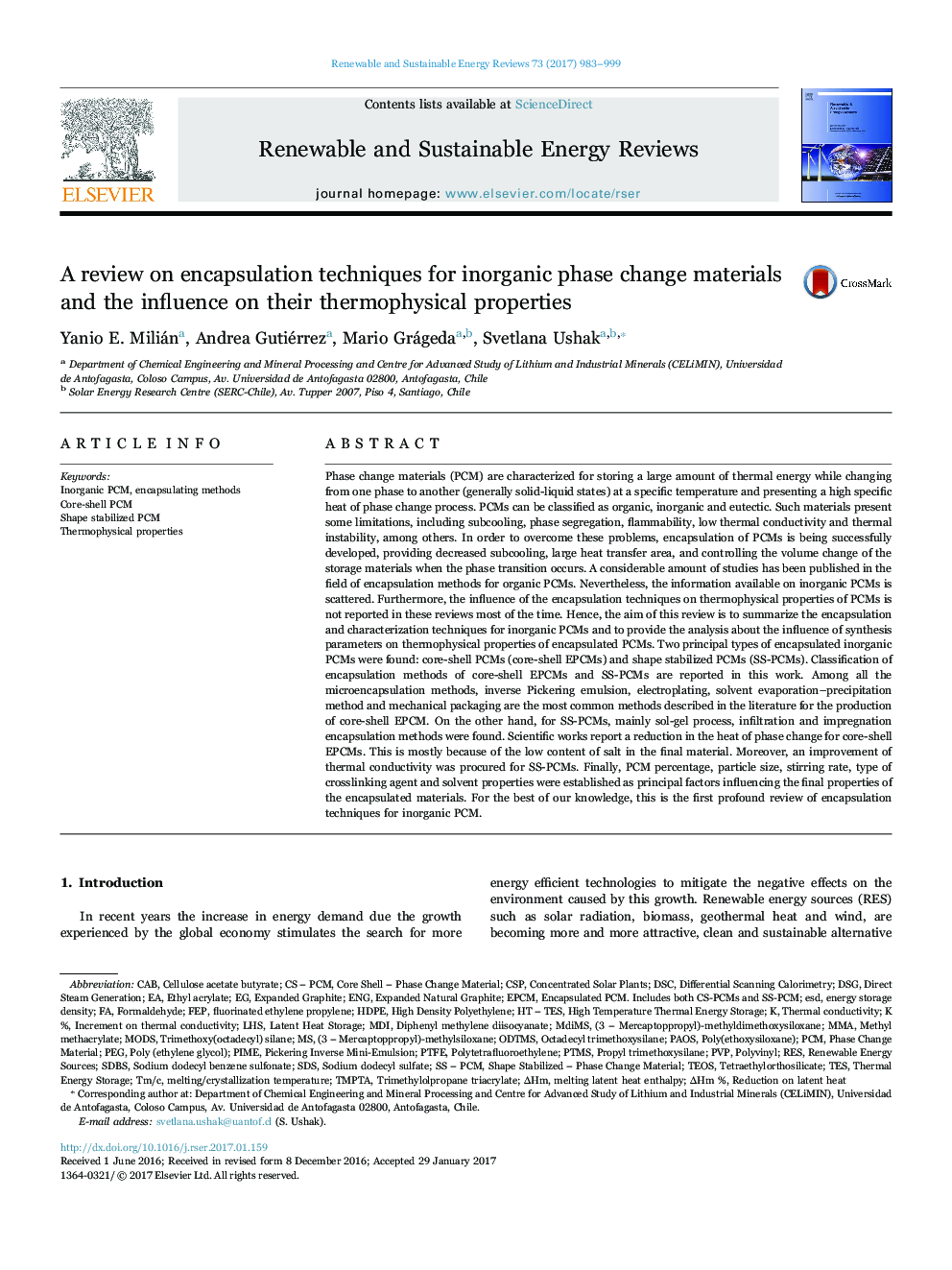| کد مقاله | کد نشریه | سال انتشار | مقاله انگلیسی | نسخه تمام متن |
|---|---|---|---|---|
| 5482314 | 1522313 | 2017 | 17 صفحه PDF | دانلود رایگان |
عنوان انگلیسی مقاله ISI
A review on encapsulation techniques for inorganic phase change materials and the influence on their thermophysical properties
ترجمه فارسی عنوان
بررسی تکنیک های انکپسولاسیون مواد تغییر فاز معدنی و تأثیر آن بر خواص ترموفیزیک آنها
دانلود مقاله + سفارش ترجمه
دانلود مقاله ISI انگلیسی
رایگان برای ایرانیان
کلمات کلیدی
MODSCSPTESDSGDSCMMAESDENGMDIRESPTMsFEPSDBSTMPTAHigh temperature thermal energy storageΔHmTrimethylolpropane triacrylateEPCMLHSPCMPTFESDSTEOSPVPHDPEPAOs - PAO هاTetraethylorthosilicate - tetraethylorthosilicateEthyl acrylate - اتیل اکریلاتfluorinated ethylene propylene - اتیلن پروپیلن فلورایدCAB - تاکسیEnergy storage density - تراکم ذخیره انرژیDirect steam generation - تولید بخار مستقیمThermophysical properties - خواص ترموفیزیکیThermal energy storage - ذخیره سازی انرژی حرارتیLatent heat storage - ذخیره گرمای خازنیThermal conductivity - رسانندگی گرماییSodium dodecyl benzene sulfonate - سدیم دودسیل بنزن سولفوناتsodium dodecyl sulfate - سدیم دودسیل سولفاتCellulose acetate butyrate - سلولز استات butyrateFormaldehyde - فرمالدئیدMMA, Methyl methacrylate - متیل متا آکریلاتRenewable energy sources - منابع انرژی تجدیدپذیر Phase change material - مواد تغییر فاز دهندهHigh density polyethylene - پلی اتیلن چگالی بالاPoly (ethylene glycol) - پلی اتیلن گلیکول)polytetrafluoroethylene - پلی تترافلورو اتیلنPEG - پلیاتیلن گلیکول Differential scanning calorimetry - کالریمتری روبشی افتراقیExpanded graphite - گرافیت انبساط یافته، گرافیت گسترش یافتهExpanded natural graphite - گرافیت طبیعی گسترش یافته است
موضوعات مرتبط
مهندسی و علوم پایه
مهندسی انرژی
انرژی های تجدید پذیر، توسعه پایدار و محیط زیست
چکیده انگلیسی
Phase change materials (PCM) are characterized for storing a large amount of thermal energy while changing from one phase to another (generally solid-liquid states) at a specific temperature and presenting a high specific heat of phase change process. PCMs can be classified as organic, inorganic and eutectic. Such materials present some limitations, including subcooling, phase segregation, flammability, low thermal conductivity and thermal instability, among others. In order to overcome these problems, encapsulation of PCMs is being successfully developed, providing decreased subcooling, large heat transfer area, and controlling the volume change of the storage materials when the phase transition occurs. A considerable amount of studies has been published in the field of encapsulation methods for organic PCMs. Nevertheless, the information available on inorganic PCMs is scattered. Furthermore, the influence of the encapsulation techniques on thermophysical properties of PCMs is not reported in these reviews most of the time. Hence, the aim of this review is to summarize the encapsulation and characterization techniques for inorganic PCMs and to provide the analysis about the influence of synthesis parameters on thermophysical properties of encapsulated PCMs. Two principal types of encapsulated inorganic PCMs were found: core-shell PCMs (core-shell EPCMs) and shape stabilized PCMs (SS-PCMs). Classification of encapsulation methods of core-shell EPCMs and SS-PCMs are reported in this work. Among all the microencapsulation methods, inverse Pickering emulsion, electroplating, solvent evaporation-precipitation method and mechanical packaging are the most common methods described in the literature for the production of core-shell EPCM. On the other hand, for SS-PCMs, mainly sol-gel process, infiltration and impregnation encapsulation methods were found. Scientific works report a reduction in the heat of phase change for core-shell EPCMs. This is mostly because of the low content of salt in the final material. Moreover, an improvement of thermal conductivity was procured for SS-PCMs. Finally, PCM percentage, particle size, stirring rate, type of crosslinking agent and solvent properties were established as principal factors influencing the final properties of the encapsulated materials. For the best of our knowledge, this is the first profound review of encapsulation techniques for inorganic PCM.
ناشر
Database: Elsevier - ScienceDirect (ساینس دایرکت)
Journal: Renewable and Sustainable Energy Reviews - Volume 73, June 2017, Pages 983-999
Journal: Renewable and Sustainable Energy Reviews - Volume 73, June 2017, Pages 983-999
نویسندگان
Yanio E. Milián, Andrea Gutiérrez, Mario Grágeda, Svetlana Ushak,
